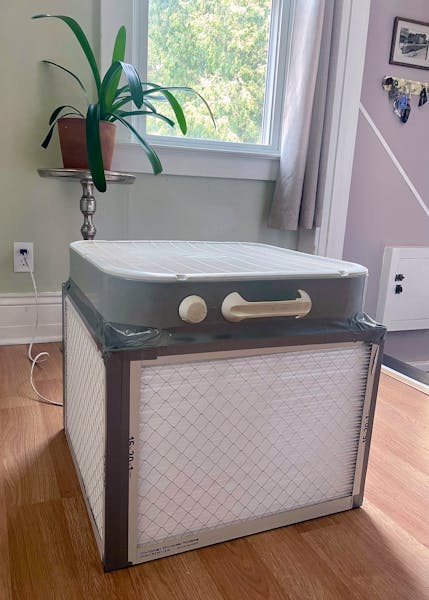Minnesota has been living through its haziest summer in recent memory, as winds repeatedly carry lung-damaging smoke south from Canada.
The Star Tribune asked readers for their questions on the smoke, how to manage it and what to do to stay healthy for the rest of the summer. Find answers below (with questions that have been edited for length and clarity):
Where do I find air quality index numbers online?
AQI readings are available from the private company PurpleAir, at map.purpleair.com, and on the Environmental Protection Agency's site, fire.airnow.gov. EPA's map also indicates where active fires are burning, and what areas are covered by smoke.
Why is the state forecast for air quality different from the numbers on outdoor monitors?
Forecasts from the Minnesota Pollution Control Agency are 24-hour averages, and the readings on monitors from PurpleAir or others might be one-hour measurements. So the AQI may fluctuate through the day to levels below or above the full-day forecast.
When air quality is deemed unhealthy for sensitive groups, how is it OK for everyone else?
AQI is separated into categories based on the severity of the health risk: orange is unhealthy for sensitive groups, red is unhealthy for everyone. Purple is very unhealthy, and maroon is hazardous.
People with breathing conditions like asthma or chronic obstructive pulmonary disease (COPD) are going to feel the effects of bad air before other people, experts say. Young people and the elderly are also more affected. But MPCA air quality meteorologist David Brown said earlier this month that these categories are on a spectrum — and it's possible otherwise healthy people will start to feel the effects shortly before the meter turns red.
Why are young children and older people more susceptible to unhealthy air?
Younger children breathe more air per pound of body weight, said Kathy Raleigh, a principal epidemiologist for the Minnesota Department of Health. They're also more likely to be exerting themselves outside by running and playing, and breathing harder.
While "every exposure we get has impact on us over time," Raleigh said, the risk to children from a bad air day is probably more short-term.
Older adults usually see a decline in the immune functions that help them clear damaging particles from the body, and are more likely to have underlying conditions that make them sensitive to smoke, Raleigh said.
Why does it feel like the air has gotten so bad so quickly? Was the air really that much cleaner 50 years ago?
On the whole, air quality in the United States has improved since the passage of the Clean Air Act. Levels of high-priority air pollutants fell 78% between 1970 and 2020, according to the EPA.
But some of these gains are being chipped away by smoke invasions and other events related to climate change, according to the American Lung Association. The group's most recent annual air quality report notes a growing disparity between the eastern part of the country and the west, where fires had started to reverse that long-term progress.
While Minnesota faced some Canadian smoke in 2021, this year's reach has been unprecedented — with smoke furling all the way to parts of Europe, according to NASA imagery.
What kinds of masks help, and do they work for other pollution, like ozone?
Experts advise that well-fitting respirators that are designed to filter tiny particles, like an N95, will offer protection for those who have to be outside. The KN95, which meets less rigorous standards, will also help but may not filter as much, Raleigh said.
Cloth masks or surgical masks won't make any difference, because the tiny particles from smoke, known as PM 2.5, will easily penetrate thinner fabrics.
Ozone—another breathing irritant that comes from the combination of sunlight and volatile compounds—is not filtered by these masks at all because it's a gas. But it can be avoided by going outside earlier in the day.
Will a window air conditioner bring smoke into my home?
Just like central air, many window air conditioning units have the option to switch between a fresh supply of air from outside or recirculating the air inside, said Pat Huelman, an adjunct professor at the University of Minnesota who studies healthy buildings. On bad air days, make sure the unit is recirculating. Most portable cooling appliances don't do much to filter the air, and it may not be possible to swap in a better filter.
If there is no button or knob giving the option to take in outside or "natural" air, then the unit is always recirculating, Huelman said. But users should make sure the unit is well insulated in the window — any gaps or cracks can let pollution sneak in.
Indoor air filters with HEPA-compliant screens can also help. It's possible to make your own version, by taping filters to a box fan.
What guidance are schools and child cares getting on responding to poor air quality?
Many schools and other groups with outdoor programming have already been bringing kids inside on bad air days. The city of Bloomington closed its outdoor pool on Tuesday.
Kevin Burns, a spokesman for the Minnesota Department of Education, directed questions to health officials and noted that "schools are not as populated" over the summer, with most classes out of session.
MDH doesn't have any official guidance for schools other than the same advice for everyone, Raleigh said — limit outdoor time when the AQI spikes to unhealthy levels.
Why isn't the jet stream carrying the smoke away from Minnesota?
Tyler Hasenstein, a meteorologist with the National Weather Service in Chanhassen, said the jet stream is constantly moving — and it hasn't been flowing over Minnesota of late. That's part of why the weather has been so hot and dry.
There are also fires burning in almost every province of Canada, meaning smoke can come from different directions. Breezes from the south don't help either, when smoke is blanketing such a broad area.
"There's about a five or six state region of the Midwest suffering under the air quality and smoke issues right now," he said.
How are these fires connected to climate change?
Generally, higher temperatures and drought make it easier for fuels on the forest floor to ignite and burn.
The Intergovernmental Panel on Climate Change notes in a 2022 report that a warmer planet is an "added stress" that can contribute to wildfires in North America. Development patterns and forest management also play a role, the IPCC said.
Canada has been remarkably dry and hot this year, starting in the spring. In the atmosphere, a persistent ridge has stopped air from ascending and rainstorms from forming, Hasenstein said. That ridge has shifted from west to east, and is now sitting over Quebec, where fire activity has exploded, the Washington Post reported.
The statistics from this fire season, which is long from over, are unprecedented — there are 477 active fires and 237 are out of control as of June 27, according to the Canadian Interagency Forest Fire Centre (CIFFC). The area burned so far across several provinces is 8 million hectares — almost the same area as Lake Superior.
What is Canada doing to put these fires out? Is the United States helping?
As of last week, 3,535 people had been deployed this year to fight fires, according to the CIFFC.
There are questions about whether more resources should have been devoted to wildland fires. The New York Times reported earlier in June that budget cuts had caused the country's firefighting corps to dwindle.
Canada is accepting international help. The CBC reported this month that Canada and the United States had signed an agreement to send wildland firefighting resources across the border more easily, though the two countries have long assisted each other with fires, including during a brutal 2020 fire season in the West.
How has the Canadian wildfire smoke been impacting you? What questions do you have about the unhealthy air in Minnesota? Please fill our our form below and leave your contact information if you're interested in having a reporter reach out to you.

Wolves vs. Nuggets series updates: Times for first four games set
Medical examiner identifies pedestrian hit by vehicle and killed in Bloomington
Souhan: A sausage? A knee surgery? Minnesota sports has gone mad

